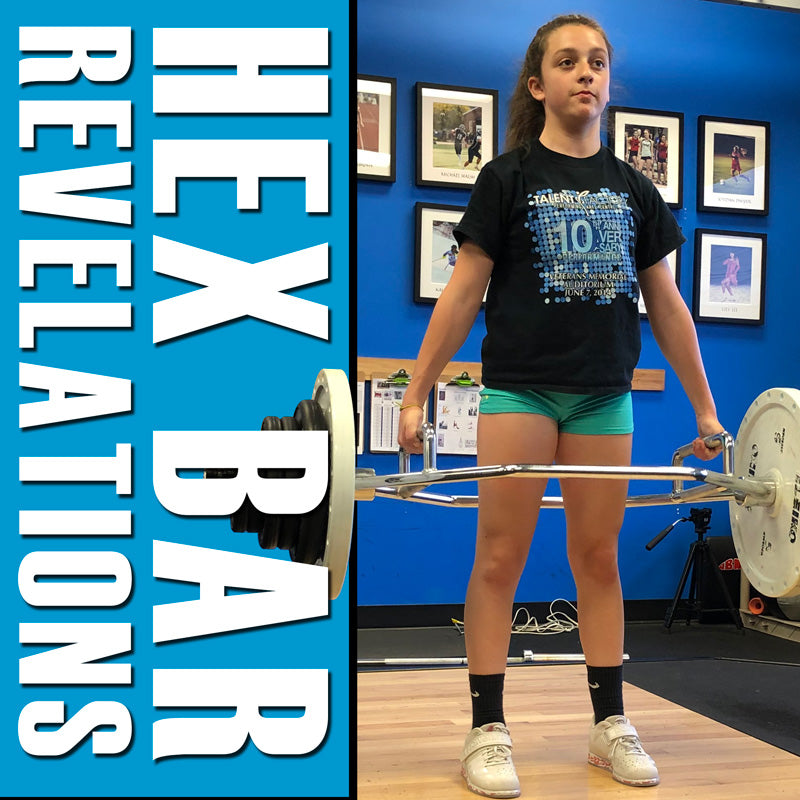HEX BAR Revelations

Look What’s New with Hex Bar Training!
When BFS was founded more than 50 years ago, the straight-bar deadlift was one of the key exercises in our total athletic fitness program for athletes. The lift was unparalleled for developing the hamstrings, glutes, and lower back. We still believe that the straight-bar deadlift is a great exercise, but found that the hex bar deadlift is better – much better.
The unique design of the hex bar enables you to perform exercises with your hands at your sides, making it easier to maintain an arch in your lower back. The major problem with a straight bar is that because the bar is in front of your legs, it’s more challenging to maintain proper technique. What often happens when using a straight bar with heavy weights is that the spine will flex excessively, shifting the stress from the muscles to the connective tissues and disks -- this rounded-back posture can cause injury.
The relative safety of the hex bar is one reason why the US Army recently decided to include it in the new version of their combat readiness assessment. In October 2020, the hex bar deadlift, along with five other tests, will replace the previous three-event combat readiness assessment instituted in 1980. The Army’s initial research on the hex bar deadlift involved 500 military personnel -- there was not a single injury, despite the soldiers giving it their all. The initial plan is for up to 40,000 soldiers to be introduced to the hex bar before the launch date.

The US Army Using the Hex Bar for Physical Fitness Training
Why the hex bar? Again, safety is one factor. In addition to the Army’s preliminary on-field research, several scientific research studies have proven the hex bar’s superiority as a test of total body strength and power.
A study published in the July 2011 issue of the Journal of Strength and Conditioning Research confirmed what strength coaches have known all along: The hex bar deadlift exerts less stress on the lower back than the straight bar deadlift. With a hex bar, the resistance is applied with the center of the barbell in line with the hips (the “power line”), which is the body’s center of mass; with a straight bar, the legs get in the way and force the lower back muscles (erector spinae) to work harder to maintain proper form. The researchers concluded, “For individuals with a history of lower back pain or currently in the final stages of rehabilitation, performing the deadlift with the hexagonal barbell rather than the straight barbell may be a more prudent strategy to target the lumbar area while more evenly distributing the load between the joints of the body.”
Five years later, another study published in the same journal found that hex bar jumps were superior to straight bar jumps in increasing “maximal force, power, and velocity.” The reason is that the hex bar involves more of the flexor muscles (such as the quads) rather than the extensor muscles (such as the lower back). This is why a hex bar is a superior tool for training “first step quickness,” such as during the start of a sprint.
Another valuable aspect of the hex bar deadlift is that it helps teach athletes how to maintain proper technique in the squat and the pull for Olympic lifting movements, such as the clean. With the hands at your sides, it’s much easier for an athlete to learn how to achieve a neutral spine posture (or, as we say at BFS, “spread the chest and lock-in the lower back”).
Of course, any discussion about the hex bar cannot be complete without mentioning Al Gerard. Gerard was a powerlifter who deadlifted 625 pounds, but whose athletic career was hampered by lower back issues. To continue training hard without traumatizing his lower back, Gerard invented a triangle-shaped bar that enabled the user to perform deadlifts and shoulder shrugs without the bar contacting the thighs. In effect, Gerard discovered what was confirmed nearly two decades later by scientific research: hex bar deadlifts enable athletes to train harder with less stress on their lower back.
Because this bar was so effective in training the trapezius, a triangle-shaped upper back muscle group, it was called the trap bar. Why place so much emphasis on the trapezius? The trapezius is involved in elevating the shoulders, such as during the finish of a power clean, and stabilizing the shoulders in military presses and other movements. Most importantly, the trapezius helps support the neck (just look at the impressive trapezius development of boxers), thus playing a valuable role in preventing neck injuries, and possibly, concussions.
In the 80s, Paul Kelso wrote several articles about the trap bar for fitness magazines, introducing it to Iron Game athletes. The popularity of Kelso’s articles led him to write a book that discussed the trap bar extensively. It was published in 1993 and was called, “The Kelso Shrug System: A Practical Guide for Body Builders and Strength Athletes.” A revised version was published in 2002.
The trap bar was a significant improvement over the straight bar, but we found that a hexagonal bar design was easier to balance and that there was more leg room for larger athletes. But we didn’t stop there.
The second variation of the hex bar was the high hex, which was identical to the hex bar except it had elevated handgrips. This design enabled the athlete to start from a higher position, making it more comfortable for tall athletes because they didn’t have to bend their knees as much as with a regular hex bar. Before this version, tall athletes often had to place the bars on blocks or bumper plates (not recommended!) so they could properly perform the exercise. But that’s not all.
For those with extreme flexibility challenges, the high hex can be used as a transitional movement before performing the standard hex bar. Beginners with extreme flexibility issues could start with high hex deadlifts for a few training sessions, and then progress to a regular hex bar. The high hex also helps break plateaus.
If an athlete can, for example, deadlift 300 pounds with a regular hex bar, they might be able to do 325 pounds with a high hex; lifting the 325 will give them the confidence to exceed 300 pounds with a regular hex bar the next time they max out. And if you’re on a budget, the good news is that you don’t have to invest in both a regular and high hex bar: BFS offers the combo hex bar, which combines a regular and a high hex bar. By simply flipping the bar over, you can perform either the regular hex or the high hex.
As a final bonus, using the high hex handles without weights enables you to perform push-ups through a greater range of motion, making the exercise considerably more challenging. This variation also places less stress on the wrists because it positions the wrists in line with the lower arms, rather than bent back.
Because the combo hex bar became so popular, and because stronger athletes were using a lot of weight in this exercise, BFS came up with the mega hex bar. The mega hex weighs 75 pounds and has longer sleeves so that much heavier weights can be used; for example, nine 45-pound Slim-Line plates can fix on each side, giving a total weight of 885 pounds!
On the other extreme, BFS also offers the youth hex bar. Slightly smaller in diameter with shorter sleeves, this bar weighs only 15 pounds. The lighter weight is perfect for young athletes in the Readiness stage of the BFS program, or those just graduating from this program. We say perfect because at BFS, we believe in teaching optimal technique before adding additional resistance. For example, an eighth-grade, 75-pound girl would probably have a hard time lifting a 45-pound hex bar with even the lightest bumper plates; with the youth hex bar, if they use our 5-pound training bumpers, they can start with as little as 25 total pounds!
Hex bar deadlifts have been an essential part of the BFS total athletic program for over 30 years, and we are continually finding new uses for this unique training tool. So pick up a hex bar – literally! -- and see what it can do for you.

